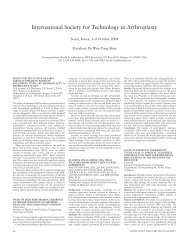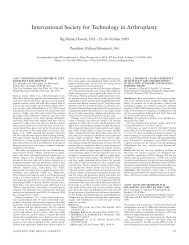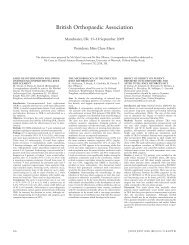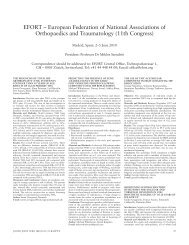Procs III 2011.indb - Journal of Bone & Joint Surgery, British Volume ...
Procs III 2011.indb - Journal of Bone & Joint Surgery, British Volume ...
Procs III 2011.indb - Journal of Bone & Joint Surgery, British Volume ...
Create successful ePaper yourself
Turn your PDF publications into a flip-book with our unique Google optimized e-Paper software.
350 HELLENIC ASSOCIATION OF ORTHOPAEDIC SURGERY AND TRAUMATOLOGY<br />
Mayo Elbow performance score, the results were excellent<br />
in 8 patients, and fair in one.<br />
We believe that the aforementioned technique is useful<br />
in treating chronic biceps ruptures. It requires no additional<br />
cost and also the risk, even if marginal, <strong>of</strong> transmitting<br />
diseases with allografts, such Achilles tendon<br />
is avoided. Furthermore, the possibility <strong>of</strong> rerupture is<br />
minimal compared to the techniques using allograft or<br />
free autografts, since a revascularisation process during<br />
which the risk for failure is high does not take place as<br />
in other types <strong>of</strong> allografts.<br />
066 HINGE FIXATOR FOR INSTABILITY OF<br />
THE ELBOW<br />
V. N. Psychoyios, A. Alexandris, S. Thoma, I.<br />
Kormpakis, A. Mpogiopoulos<br />
5th Orthopaedic Department, Hand Unit,<br />
Asklipeion Hospital <strong>of</strong> Voula, Athens<br />
Hinged external fi xators <strong>of</strong> the elbow joint can be a<br />
valuable tool in managing complicated trauma associated<br />
with instability, instability after contracture release,<br />
and distraction interposition arthroplasty or distraction<br />
arthroplasty alone. This retrospective study focuses<br />
on the performance <strong>of</strong> the device in acute and chronic<br />
elbow instability associated with complex injuries<br />
around the elbow.<br />
Thirteen hinged external fi xators were applied in 13<br />
patients with an average age <strong>of</strong> 46 years. All fi xators<br />
were applied for various types <strong>of</strong> fractures around the<br />
elbow joint associated with elbow dislocation. In 12<br />
patients prior to the application <strong>of</strong> the fi xator, a formal<br />
open reduction and internal fi xation was performed so<br />
as to neutralise the whole construct and permit early<br />
mobilisation <strong>of</strong> the joint. In one patient with a minimally<br />
displaced fracture which required no internal fi xation<br />
the fi xator was used to permit early mobilisation. A<br />
circular multiplanar frame was used in 4 patients and a<br />
unilateral one in the rest <strong>of</strong> them.<br />
Eight out <strong>of</strong> 13 patients with fracture-dislocation<br />
had an uneventful outcome. Three patients required a<br />
revision surgery to correct a fracture malalignment and<br />
a subluxation <strong>of</strong> the joint. The results were evaluated<br />
according to the Mayo Elbow Performance score. Complications<br />
included 4 cases <strong>of</strong> pin tract infection and 2 <strong>of</strong><br />
transient ulnar neuritis.<br />
Despite the complexity <strong>of</strong> its application and the<br />
complications that may follow such device, an articulating<br />
external fi xator can be a valuable tool in treating<br />
complex elbow instability.<br />
067 REVERSE SHOULDER ARTHROPLASTY.<br />
INDICATIONS – CLINICAL RESULTS<br />
P. Papadopoulos, D. Karataglis, A. Boutsiadis,<br />
F.Agathaggelidis, V.Alexopoulos, A.<br />
Christodoulou<br />
1st Orthopaedic Department, Aristotelion<br />
University <strong>of</strong> Thessaloniki, General Hospital<br />
Papanikolaou<br />
Although, reverse shoulder arthroplasty has initially<br />
been introduced for rotator cuff arthropathy, its application<br />
has been expanded on fracture sequelae, chronic<br />
dislocations and even comminuted fractures <strong>of</strong> the<br />
humeral head in elderly patients. The purpose <strong>of</strong> this<br />
study is to present our experience and the mid-term<br />
clinical results <strong>of</strong> this type prosthesis.<br />
Between 2006 and 2008 16 reverse shoulder arthroplasties<br />
have been carried out in our department. Fourteen<br />
patients were female and 2 male with an average<br />
age <strong>of</strong> 72.4 years (55-81). Eleven patients had true rotator<br />
cuff arthropathy, 3 malunion <strong>of</strong> 4-part fractures, one<br />
chronic anterior shoulder dislocation and fi nally one<br />
patient had bilateral chronic posterior shoulder dislocation.<br />
In 2 cases we used the Delta prosthesis and in a<br />
further 14 cases the Aquealis Arthroplasty.<br />
Routine postoperative follow up was at 3,6,12 and<br />
24 months and included plain radiographic control and<br />
clinical evaluation with the Constant Shoulder Score.<br />
All patients report signifi cant pain relief and an average<br />
improvement <strong>of</strong> the Constant Score from 40.5 to 72.3.<br />
Two patients had anterior dislocation <strong>of</strong> the prosthesis<br />
4 days postoperatively and we proceeded to the application<br />
<strong>of</strong> a 9 mm metal spacer and bigger polyethylene<br />
size. In one patient neuroapraxia <strong>of</strong> the axillary nerve<br />
was observed; this resolved 3 months postoperatively.<br />
Continuous clinical improvement was observed in some<br />
patients up until 18 months postoperatively.<br />
Our clinical results are very satisfactory and reveal that<br />
reverse shoulder arhroplasty is a very good option for a<br />
broad spectrum <strong>of</strong> pathologic shoulder conditions.<br />
068 FLOATING ELBOW. SURGICAL<br />
TREATMENT: MID-TERM RESULTS<br />
A. Boutsiadis, K. Ditsios, P. Savvides, S. Stavridis,<br />
P. Givisis, A. Christodoulou<br />
1st Orthopaedic Department, Aristotelion<br />
University <strong>of</strong> Thessaloniki, General Hospital<br />
Papanikolaou<br />
Although, reverse shoulder arthroplasty has initially<br />
been introduced for rotator cuff arthropathy, its application<br />
has been expanded on fracture sequelae, chronic<br />
dislocations and even comminuted fractures <strong>of</strong> the<br />
humeral head in elderly patients. The purpose <strong>of</strong> this<br />
study is to present our experience and the mid-term<br />
clinical results <strong>of</strong> this type prosthesis.<br />
Between 2006 and 2008 16 reverse shoulder arthroplasties<br />
have been carried out in our department. Fourteen<br />
patients were female and 2 male with an average<br />
age <strong>of</strong> 72.4 years (55-81). Eleven patients had true rotator<br />
cuff arthropathy, 3 malunion <strong>of</strong> 4-part fractures, one<br />
chronic anterior shoulder dislocation and fi nally one<br />
patient had bilateral chronic posterior shoulder dislocation.<br />
In 2 cases we used the Delta prosthesis and in a<br />
further 14 cases the Aquealis Arthroplasty.<br />
Routine postoperative follow up was at 3,6,12 and<br />
24 months and included plain radiographic control and<br />
clinical evaluation with the Constant Shoulder Score.<br />
All patients report signifi cant pain relief and an average<br />
improvement <strong>of</strong> the Constant Score from 40.5 to 72.3.<br />
Two patients had anterior dislocation <strong>of</strong> the prosthesis<br />
4 days postoperatively and we proceeded to the application<br />
<strong>of</strong> a 9 mm metal spacer and bigger polyethylene<br />
size. In one patient neuroapraxia <strong>of</strong> the axillary nerve<br />
was observed; this resolved 3 months postoperatively.<br />
Continuous clinical improvement was observed in some<br />
patients up until 18 months postoperatively.<br />
Our clinical results are very satisfactory and reveal that<br />
reverse shoulder arhroplasty is a very good option for a<br />
broad spectrum <strong>of</strong> pathologic shoulder conditions.<br />
069 SURGICAL TREATMENT OF RADIAL<br />
HEAD FRACTURES IN COMPLEX ELBOW<br />
INJURIES<br />
V.N. Psychoyios, P. Intzirtzis, S. Thoma, V.<br />
Bavellas, E. Zampiakis<br />
5th Orthopaedic Department, Hand Unit,<br />
Asklipeion Hospital <strong>of</strong> Voula, Athens<br />
Radial head fractures are the most common fractures<br />
occurring around the elbow and are <strong>of</strong>ten associated with<br />
other fractures or s<strong>of</strong>t tissue injuries in the elbow. The<br />
purpose <strong>of</strong> this study was to characterise the morphology<br />
and to evaluate the outcome <strong>of</strong> the surgical management<br />
<strong>of</strong> radial head fractures in complex elbow injuries.<br />
Nineteen patients with this pattern <strong>of</strong> injury underwent<br />
surgical treatment in our unit. In addition, seven<br />
patients had posterior dislocation <strong>of</strong> the elbow, 2 medial<br />
collateral ligament rupture, one capitellar fracture, 3 posterior<br />
Monteggia, 1 Essex-Lopresti lesion and 5 coronoid<br />
fracture plus posterior dislocation. Non comminuted<br />
radial head fractures were treated by open reduction and<br />
internal fi xation or simple excision <strong>of</strong> small fragments.<br />
Patients with comminuted, displaced radial head fractures<br />
underwent radial head replacement.<br />
The average follow up was 44 months. Two patients<br />
developed post-traumatic elbow contractures, one elbow<br />
instability and 2 mild arthritis. Overall, according to the<br />
DASH Outcome Measure, the results were excellent in<br />
12 patients, fair in 3 and poor in 4.<br />
In complex injuries <strong>of</strong> the elbow the characteristics <strong>of</strong><br />
the radial head fracture and in particular the comminution,<br />
the fragment number, the displacement as well as<br />
the age <strong>of</strong> the patient should determine the appropriate<br />
surgical technique which will lead to satisfactory longterm<br />
results. Anatomical restoration and maintenance <strong>of</strong><br />
elbow stability will allow early mobilisation <strong>of</strong> the elbow<br />
joint and should be the goals <strong>of</strong> surgical management.<br />
070 OUTCOME OF FLEXOR CARPI RADIALIS<br />
TENDON TRANSFER FOR RADIAL NERVE<br />
PALSY<br />
N. Korres, I. Kormpakis, S. Thoma, V. Bavellas, E.<br />
Zampiakis, P. A. Kinnas<br />
5th Orthopaedic Department, Hand Unit,<br />
Asklipeion Hospital <strong>of</strong> Voula, Athens<br />
Among the most popular techniques for the management<br />
<strong>of</strong> radial nerve palsy is the transfer <strong>of</strong> the Pronator Teres<br />
(PT) to the Extensor Carpi Radialis Brevis (ECRB), <strong>of</strong> the<br />
Flexor Carpi Radialis (FCR) to the Extensor Digitorum<br />
Communis (EDC) and <strong>of</strong> the Palmaris Longus (PL) to<br />
rerouted Extensor Pollicis Longus (EPL). This retrospective<br />
study was undertaken to assess the outcome <strong>of</strong> fl exor carpi<br />
radialis transfer in the treatment <strong>of</strong> radial nerve palsy.<br />
Twenty patients with a mean age <strong>of</strong> 36 years were<br />
included in this study. Surgical management, as described<br />
above, was decided since all patients had irreparable damage<br />
to the nerve. Parameters that were assessed included range<br />
<strong>of</strong> wrist motion, dynamic power <strong>of</strong> wrist fl exion and extension,<br />
and radial and ulnar deviation and function.<br />
The average follow-up was 4.5 years. Compared to a<br />
control group <strong>of</strong> 10 volunteers <strong>of</strong> similar characteristics,<br />
all patients achieved a functional range <strong>of</strong> motion and<br />
satisfactory power <strong>of</strong> wrist motion. All patients returned<br />
to their previous occupation.<br />
Transfer <strong>of</strong> Flexor Carpi Radialis tendon for irreparable<br />
radial nerve palsy yields satisfactory results.<br />
Therefore, it can be expected that patients will obtain<br />
a functional range <strong>of</strong> motion as well as an adequate<br />
strength <strong>of</strong> motion.<br />
071 REPLACEMENT OF THE RADIAL HEAD<br />
WITH A PYROCARBON HEAD PROSTHESIS:<br />
MIDTERM RESULTS. AIM OF THE STUDY<br />
I. Sarris, M. Kyrkos, N. Galanis, G. Kapetanos<br />
3rd Orthopaedic Department Aristotelion<br />
University <strong>of</strong> Thessaloniki, Papageorgiou General<br />
Hospital<br />
The aim <strong>of</strong> this study is the presentation <strong>of</strong> the midterm<br />
results <strong>of</strong> the radial head replacement with pyrocarbon<br />
head prosthesis (MoPyc).<br />
Thirty two patients (20 males and 12 females) with<br />
a mean age <strong>of</strong> 54 y.o. (32-68 y.o.) were subjected to<br />
replacement <strong>of</strong> the radial head with a pyrocarbon head<br />
prosthesis. Twenty <strong>of</strong> them had a comminuted radial<br />
head fracture(15 Mason IV type and 5 Mason <strong>III</strong>), two<br />
had a malunion and ten had a complex elbow injury (ligamentous<br />
rupture and comminuted radial head fracture<br />
with/without coronoid process fracture). In 22 patients<br />
the fracture was on the dominant side. The mean follow<br />
up time was 27 months (21 – 46 months).<br />
The post-operative results were:<br />
1) The mean range <strong>of</strong> motion in fl exion-extension was<br />
130° (105° to 150°), while in pronation and supination<br />
was 74° (60°-80°).<br />
2) The mean grip strength was 96% <strong>of</strong> the contralateral<br />
side.<br />
3) There was no clinical laxity in the varus or valgus<br />
stress test.<br />
4) According to the Broberg-Morrey score the good and<br />
excellent result were 77%, while according to the<br />
Mayo Clinic Elbow Performance Score (MEPS) good<br />
and excellent results were up to 97% <strong>of</strong> the total.<br />
Pain was evaluated with a visual analogue scale.<br />
Finally there was also a radiographic evaluation <strong>of</strong><br />
the patients (that yielded six cases <strong>of</strong> loosening or<br />
osteolysis without any clinical manifestation)<br />
Replacement <strong>of</strong> the radial head with the specifi c prosthesis<br />
leads to very satisfactory results when performed<br />
under specifi c indications.<br />
J BONE JOINT SURG [BR] 2011; 93-B:SUPP <strong>III</strong>








